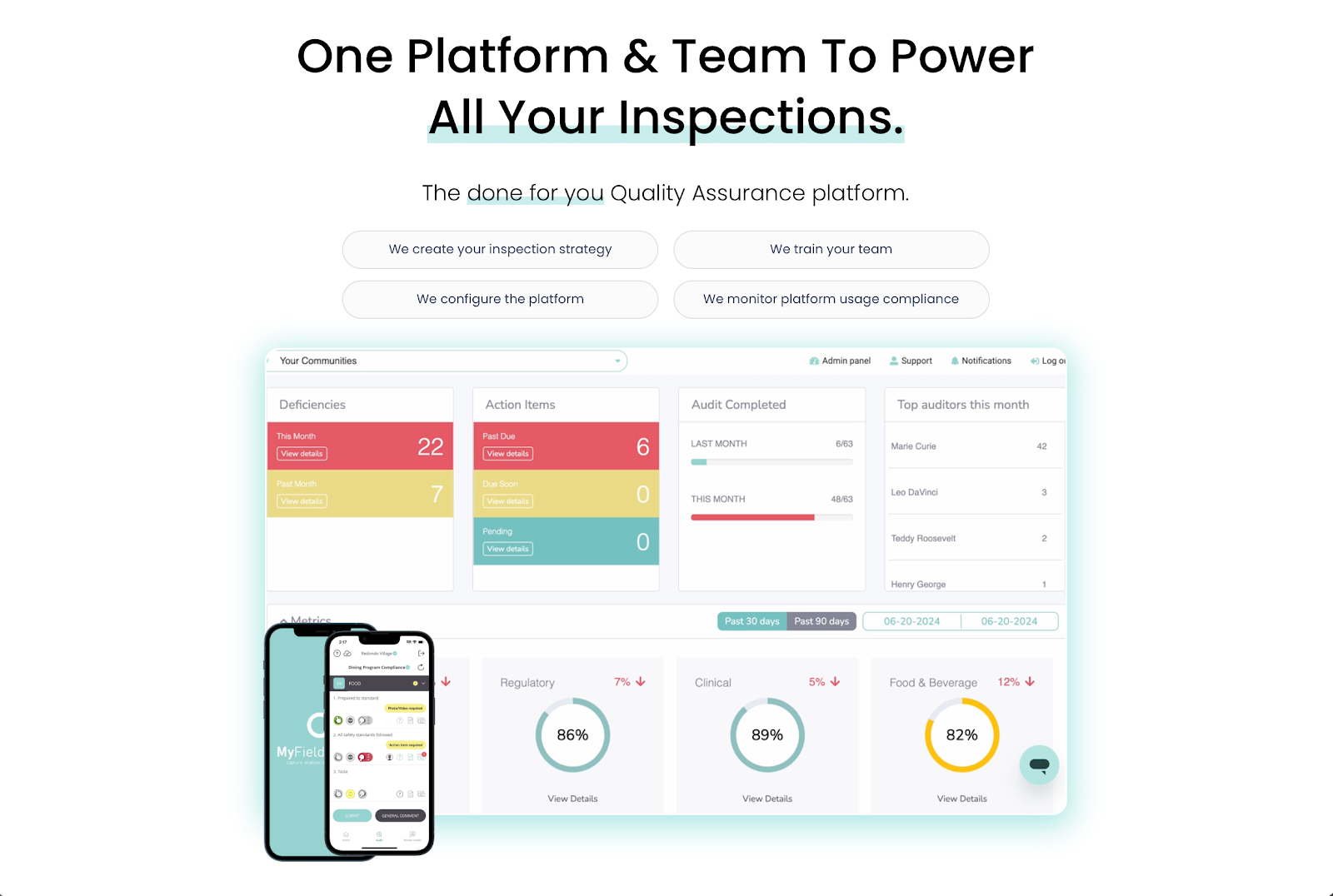.svg)
Food and Beverage Industry Regulations and Compliance Guide

Take Control of QA.
Make Inspections Effortless.

We’ll quickly uncover your needs and share how we can help—no pressure, no stress, just solutions. Grab your spot on our calendar today!
Be survey-ready every day with three simple dining audits

We’ll quickly uncover your needs and share how we can help—no pressure, no stress, just solutions. Grab your spot on our calendar today!
If you manage food and beverage operations, compliance with regulatory requirements isn't something you think about once a year. Instead, it’s part of your daily work.
Every detail matters, from how you store food to how you train employees. One missed step could lead to fines, business shutdowns, or lost clients.
However, food and beverage regulations are constantly changing at the federal, state, and local levels. This means staying compliant and keeping teams aligned are increasingly becoming difficult.
In this guide, you'll learn what rules apply, who enforces them, and what's changed recently. You'll also get insight into how to maintain food and beverage regulatory compliance without getting buried in paperwork and operational chaos.
Who Regulates the Food and Beverage Industry?
Several regulatory bodies enforce rules that cover your food and beverage company:
Food and Drug Administration (FDA)
The FDA regulates most packaged foods, processed goods, and food labeling. It’s one of the main government agencies setting national food safety standards.
The FDA can also oversee the entire food supply chain, from manufacturing to retail, to ensure compliance with regulations. It also promotes supply chain transparency.
This federal government agency can even take action against food and beverage businesses that violate food safety or labeling laws.
U.S. Department of Agriculture (USDA)
The USDA handles the safety of high-risk foods, such as meat, poultry, and egg products. These categories have their own rules, inspections, and grading systems.
Through the National Organic Program (NOP), the USDA regulates the production, handling, labeling, and enforcement of all organic and raw materials.
The Department of Agriculture also oversees the import and export of food products to prevent foodborne illnesses and other potential hazards.
Alcohol and Tobacco Tax and Trade Bureau (TTB)
This government agency regulates the production, labeling, and importation of alcohol. It deals with any beverage manufacturer who sells and imports alcohol, especially when crossing state lines.
The TTB enforces the provisions of the Federal Alcohol Administration (FAA) Act. They protect consumers and ensure the integrity of the beverage industry.
Occupational Safety and Health Administration (OSHA)
OSHA is a federal government agency that oversees workplace health and safety in all industries, including the food and beverage sector.
OSHA can enforce safety standards, conduct regular workplace inspections, and require employee training to make sure staff members are properly trained to handle hazards.
State-Level Regulators
Each U.S. state enforces its own food safety codes, which may build on or differ from federal rules. These codes often govern licensing standards, inspections, and food safety certification programs.
If you operate in multiple states, you’re likely juggling different requirements. This is why you need food safety compliance systems that provide real-time visibility across locations.
Local Health Departments
At the local level, your county or city health department is usually the one conducting routine inspections.
These regulators score or grade your establishment's cleanliness, food handling, storage, pest management, and disease control. Minor violations will cost you your "A" score and negatively affect your reputation in the industry.
Visibility is important to help you prepare for inspections and build trust. This trust increases client retention.
What Are Food and Beverage Industry Regulations and Compliance Requirements?
After learning who sets industry regulations, it's time to understand which specific requirements food and beverage manufacturers should follow. Below are the most popular ones:
FDA Food Code
The FDA Food Code includes best practices to guarantee safe food handling and human consumption. It serves as a model for state and local health regulations.
Most states and food manufacturers use this code to develop their own food safety rules and align with national food regulatory policy.
The FDA Food Code significantly reduces the risk of foodborne illness and protects public health by ensuring food safety.
Food Safety Modernization Act (FSMA)
The FSMA requires a proactive approach to food safety. It focuses on preventing problems before they happen, rather than reacting after issues arise.
This federal law applies to farms, processors, distributors, and restaurants. It also covers imported food, requiring certification and other measures from global markets to ensure safety.
If you're a food and beverage operator, you need to create written food safety and risk management plans, monitor hazards, and record compliance efforts. Doing so helps you prepare for FSMA compliance audits.
Food Allergen Labeling and Consumer Protection Act (FALCPA)
The FALCPA mandates clear labeling of major allergens, including milk, eggs, fish, peanuts, wheat, and soy. It’s designed to protect allergic consumers and requires accurate ingredient lists.
If you produce or sell packaged food, this law applies to you. Mislabeling can lead to product recalls or legal action. You need to have checks in place to verify labels and ensure consumer safety.
Food Safety and Inspection Service (FSIS) Policies
The FSIS is a division of the USDA responsible for inspecting meat, poultry, and processed egg products. Its oversight is grounded in several federal laws, including:
- Federal Meat Inspection Act (FMIA): It requires all meat sold in interstate commerce to be inspected for safety, wholesomeness, and accurate labeling. It mandates on-site federal inspectors at slaughter and processing plants.
- Poultry Products Inspection Act (PPIA): This makes sure poultry products are safe, properly labeled, and not adulterated. Like the FMIA, it requires federal inspection of all poultry prepared for commercial distribution.
- Egg Products Inspection Act (EPIA): It oversees the processing and proper labeling of egg products. It also involves pasteurization and regular inspection of facilities to prevent contamination.
- Humane Methods of Slaughter Act (HMSA): This law requires livestock to be slaughtered using humane methods that minimize suffering. It supports both ethical treatment and meat quality during food processing.
Hazard Analysis and Critical Control Points (HACCP)
HACCP is a method used to identify and control risks in food production. It focuses on "critical control points" where contamination can happen, like cooking, cooling, or food packaging.
Food producers and restaurants should closely monitor these CCPs and implement corrective actions to address food safety risks. Having a clear framework to follow can also help in HACCP audit preparation.
PFAS in Food Contact Applications
Per- and polyfluoroalkyl substances (PFAS) are chemicals once used in food packaging. Recent studies now link them to health risks.
This is why several states and the FDA have moved to restrict PFAS in wrappers, containers, liners, and grease-proofers.
If your business uses disposable items, you should check your packaging sources. You may need to update supplier agreements or switch materials to maintain regulatory compliance.
That said, the FDA still authorizes the use of PFAS on non-stick pans, gaskets in food processing equipment, and manufacturing aids.
State Licensing and Permits
Before opening or expanding your food and beverage business, you should get proper licenses and permits. These include food service permits, health department permits, liquor licenses, and certificates of occupancy.
Every state and city has its own regulatory requirements. It's important to know these rules to ensure compliance.
You should also pass regular inspections and pay fees to remain compliant with state-specific laws.

Other Recent Regulatory Developments
Regulations affecting the food and beverage industry often change. Below are the key updates that you should be aware of:
- Supplement to the 2022 Food Code: The FDA released a supplement to the 2022 Food Code, incorporating recommendations from the 2023 Conference for Food Protection. It adds new provisions addressing the disinfection of food surfaces, expands how and when containers can be refilled, and improves awareness of food defense measures.
- Final food traceability rule: The FDA finalized a rule requiring additional traceability records for producers that handle foods included on the Food Traceability List (FTL). This ensures faster identification and instant removal of potentially contaminated food.
- Use of the "healthy" label: The FDA updated the criteria for using the "healthy" claim on food labeling. Products must now meet specific nutrient content requirements, including limits on added sugars, saturated fat, and sodium.
- Strengthening organic enforcement: The USDA's Agricultural Marketing Service implemented a final rule to strengthen organic enforcement. This includes improved oversight of organic imports and clarified certification standards to protect the integrity of the organic label.
- Prohibited use of brominated vegetable oil: The FDA restricts the use of brominated vegetable oil (BVO) in food after studies revealed its potential adverse health effects. This leads to the removal of BVO from the list of approved food additives.
- State-level bans on polystyrene foam containers: Several U.S. states, including Maryland, New York, and New Jersey, have enacted bans on polystyrene foam containers. These measures aim to reduce environmental pollution and encourage the use of sustainable packaging alternatives.
Common Challenges Operators Face With Food and Beverage Compliance
Like many food and beverage operators, you may find it difficult to comply with requirements. Here are the common challenges you might encounter:
- Inconsistent standards across locations: If you manage multiple sites, each location might interpret standards in its own way. This leads to misalignment between teams, uneven data collection, and audit failures.
- Limited visibility into daily operations: Without real-time updates, it’s hard to know what is happening on the ground, which makes accountability and performance tracking nearly impossible.
- Manual and paper-based records: Spreadsheets and clipboards are easily lost, misfiled, or outdated, leaving you vulnerable during inspections.
- Delayed reporting: When reports come in days late, your operators can’t respond fast enough to fix problems before they impact safety or customer satisfaction. You also can't show proof of performance to clients.
- Regulatory overlap: Federal, state, and local rules often contradict or duplicate each other. This creates confusion and compliance fatigue among your teams.
- Keeping up with evolving regulations: Laws and compliance standards constantly change. Unfortunately, you don’t have enough time to monitor every change or interpret its impact.
- Managing global standards: If you export or import goods in the European Union, United Kingdom, or any country outside the U.S., you need to comply with international standards. This adds another layer of complexity to already demanding workflows.
Consequences of Non-Compliance in the Food and Beverage Industry
Non-compliance has damaging effects on your operations. It typically starts with fines, failed inspections, and legal repercussions, but it doesn't stop there.
You also risk civil lawsuits, license suspension, and even business shutdowns. All these can lead to lost revenue because you aren't allowed to operate, and customer perception has changed.
Plus, when reporting is late or inconsistent, clients start to ask, “What exactly are we paying for?” Trust breaks down if you don't show clear proof of performance. You end up losing enterprise clients, which directly affects your bottom line.
8 Best Practices to Achieve Food and Beverage Compliance
After understanding what happens when compliance breaks down, it's time to learn how to avoid those consequences. Here are the best practices you can implement:
1. Conduct Routine Mobile Inspections
Waiting for official audits isn’t enough. Your operators need instant visibility into what is happening on the ground.
With mobile inspection software tools, you can conduct field inspections across dozens of locations. You can also generate reports in real time without chasing people down. Doing so gives your leadership team and clients instant access to accurate records.
Routine mobile inspections even help you identify compliance risks early, so you’re not blindsided during external reviews. It’s one of the easiest ways to stay audit-ready without disrupting daily operations.
2. Standardize Food Operating Procedures Across Locations
Inconsistent execution leads to failed inspections and client complaints. You should use checklists, training protocols, and consistent reporting formats to create effective food standard operating procedures.
You can also ensure consistency across multi-site operations by centralizing data and giving everyone access to the same tools.
When each team is working from the same playbook, you reduce errors and increase visibility. This builds trust with enterprise clients.
3. Document Everything in Real Time
Delayed reports and missing logs can lead to non-compliance. To avoid this, you should capture inspection data, corrective actions, staff responses, and consumer preferences on the spot.
Detailed documentation removes the guesswork and provides the audit trail that regulatory bodies expect. It also serves as proof of performance, which you can share with clients and increase retention.
Plus, centralized and up-to-date data can keep everyone on the same page. It closes communication gaps, which can align site teams, operators, and clients around a single goal.
4. Train Teams Consistently
Every employee plays a role in compliance. This is why training can’t be a one-time event.
You should build training into your onboarding process and run regular refreshers to reinforce food safety protocols, labeling rules, and personal hygiene standards.
When possible, integrate lessons into mobile inspection tools so teams are reminded of the flow of work. Pair this with clear accountability, so that standards become part of your company culture and not just a checklist.
5. Prepare for Audits Before They Happen
If your team scrambles before each audit, something is broken.
You should treat compliance as a top priority. Run internal audits every week and review flagged issues with site managers.
Use internal audit management software to simulate official inspections, fix gaps, and improve your compliance strategy in real time.
The goal isn’t to just “pass” inspections. You need to build a reputation for being audit-ready at all times. Clients remember that level of professionalism.
6. Stay Proactive With Regulatory Updates
Food safety rules change fast. Whether it’s the FDA, USDA, or your state health department, staying current and compliant is non-negotiable.
Assign one person or team to track changes and share updates with your staff. Focus especially on laws around allergens, traceability, and risk-based preventive controls, as these are frequent audit points.
You can also subscribe to regulatory agency websites and newsletters. Alternatively, follow industry associations and professional organizations for regulatory updates.
This helps you revise key processes as soon as regulations change, so you don’t fall behind and risk citations or costly recalls.
7. Invest in Technology
Manual systems can’t keep up with consumer demand and the scale of modern food and beverage operations.
Use software for the food industry to capture real-time data, conduct field inspections, share reports, and gain complete oversight of your operations.
With the right tools, your team spends less time chasing paperwork and more time fixing problems before they impact food safety or client trust.
8. Partner With Industry Experts
You don’t have to solve compliance alone. Partnering with food safety consultants, legal advisors, or technology providers gives your team access to expert insights.
For example, MyFieldAudits offers not just software, but also a white-glove support team to help you solve problems across multiple sites. Having this level of guidance makes it easier to stay compliant and grow with confidence.
Watch this video to see how MyFieldAudits handles the heavy lifting for your business!
Achieve Food and Beverage Compliance Across All Locations With MyFieldAudits

MyFieldAudits helps food and beverage operators meet compliance requirements by managing the entire lifecycle of on-site inspections.
They provide a mobile inspection platform that gives you real-time visibility into multiple locations. This eliminates the need for paperwork, spreadsheets, or chasing down people.
With MyFieldAudits, you can instantly conduct field inspections, generate reports, and centralize data to keep everyone aligned.
You can also share proof of performance with clients while showing regulatory bodies that you comply with safety and quality standards.
In addition to giving you software access, MyFieldAudits handles the platform configuration, team training, and compliance monitoring for your business. Their support team can solve real issues you're facing, so you can focus on improving performance and retaining clients.
Schedule a demo today to achieve regulatory compliance! You can also check this product overview to learn how MyFieldAudits can benefit your operations.
FAQs About Food and Beverage Industry Regulations and Compliance
What is regulatory compliance in the food industry?
Regulatory compliance means following all local, state, and federal rules that apply to how food is made, handled, labeled, and served. It includes food safety practices, employee training, sanitation, and recordkeeping. Staying compliant helps protect public health and prevents legal or financial consequences for your business.
What are the 7 most important food safety rules?
The seven main food safety rules are keeping food clean, separating raw and cooked foods, cooking thoroughly, storing food at safe temperatures, using safe water and ingredients, maintaining good personal hygiene, and avoiding cross-contamination. These practices help prevent foodborne illnesses and maintain regulatory compliance.
What are the 4 phases of compliance?
The four phases of compliance include planning, implementation, monitoring, and review. In the planning phase, businesses identify legal requirements. During implementation, they apply the necessary procedures. Monitoring ensures that regulations are followed, and review involves assessing and improving compliance systems to keep up with changing industry standards.
What are the 5 steps to compliance?
The five steps to food and beverage compliance involve identifying regulations, assessing risks, developing policies, training staff, and conducting audits. This process helps ensure that all employees understand the rules and follow them consistently.
%201.svg)






%201%20(1).svg)